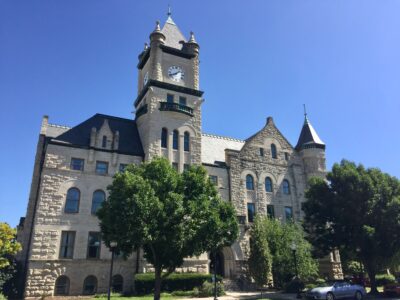‘Swamplandia!’ author Karen Russell discusses the inspiration for her new novel ahead of her Lawrence visit

photo by: Contributed
Karen Russell and the cover of her 2025 novel.
Fans of author Karen Russell have two things to look forward to this week: One, the long-awaited release of her second novel, “The Antidote,” on Tuesday; and, two, the opportunity to hear her read from it on Saturday in Lawrence.
Russell, speaking to the Journal-World recently from her home in Portland, Oregon, likewise expressed enthusiasm for the coming days.
“I am super excited to come to Lawrence,” she said. “I’m not kidding, I had one of the greatest nights after an event in Lawrence (about a decade ago), meeting a lot of ‘book people,’ and I loved it. … Lawrence is a place of amazing history.”
That history, and specifically Lawrence’s proximity to two of the greatest tragedies in U.S. history — the violent removal of Native Americans from their homes and subsequent catastrophic plowing of prairie grasses, which led to the Dust Bowl — is at the heart of Russell’s first novel in 14 years and is why Lawrence is among the first stops on her book tour.
“I just felt it important to go to some of the places where people have family ties to this history,” Russell said.
One of those places is Haskell Indian Nations University, which gets a brief mention in the novel along with other government boarding schools that were meant to forcibly “educate” Native Americans out of their culture while simultaneously isolating them on society’s margins. (Russell calls the mass layoffs that have just recently disrupted Haskell “devastating” … Of her novel, she tells the Journal-World, “I’m treading into times that are very much alive for a lot of people.”)
Her best-selling debut novel, 2011’s Pulitzer finalist “Swamplandia!,” featured a distinctive geography, the humid backwaters of Florida, where Russell grew up. In “The Antidote,” the physical terrain is the bone-dry Midwest of the Dust Bowl — specifically a tiny Nebraska town called Uz that is reeling from the Black Sunday storm of April 14, 1935, one of the most destructive “dusters” in American history.
“Nobody who didn’t live through it can ever understand it,” one of the book’s main characters says.
The book features four main characters — an orphaned, basketball-loving teenage girl; her farmer uncle, who is the son of a Polish immigrant; a Black female photographer from Franklin Roosevelt’s Farm Security Administration; and the book’s namesake, “The Antidote,” whose job as a “prairie witch” drives much of the action.
A prairie witch, which Russell also calls a “vault,” is a woman whom the townspeople go to when they want to rid themselves of a troublesome memory, something bad that happened to them or something shameful they want to forget — a secret crime, say, or an affair, a shattered heart, “whatever they cannot stand to know.” They deposit the memory in the witch’s body via an earhorn, and she gives them a deposit slip in case they ever want to retrieve it.
“I had this idea for these memory witches, these women who store and absorb memories for people, and that was sort of the first seedling of this book,” Russell said.
The deposited and forgotten memories function, at first, as blinders to help people move more peacefully through life. But what happens to the townspeople’s humanity as a result? And what if the witch loses her ability to retrieve the deposits?
“For a little while, she’s stabilizing the town in a way,” Russell says. “But she’s also kind of robbing them of the opportunity to imagine another kind of world. She’s taking that chance away from them to heal or to seek repair.”
And the “collapse of memory,” whether in an individual or in the collective, inevitably leads to omissions in history and repeated wrongs — an unending cycle of damage to human beings and to the earth.
Russell’s prairie witch, who shares her own harrowing narrative of loss throughout the novel, gains insights into the role she has played in the town’s life, and her story intertwines with those of other “female disruptors” in the book.
One is the young basketball player (partly inspired by Russell’s real-life best friend, a “ferocious and incredible athlete”) who eschews the gentler “pass-dribble-pass” rules for girl’s basketball, opting for a more warlike sport.
“Its speed and its violence would have stunned Dr. Naismith,” Russell writes in the novel, referring to Lawrence’s own beloved inventor of basketball, James Naismith.
Like many Lawrencians, the character Asphodel Oletsky worships the game and prays “to the God who loves to win.”
Another disruptor is the FSA photographer, modeled on the likes of Dorothea Lange and Kansas’ own Gordon Parks, whose pictures, with a kind of magical realism, reveal things that aren’t currently there but that were at one time or will be in the future.
Russell said the haunted camera became “one of my favorite parts of this book.”
“I love the idea of something coming into focus in a darkroom,” Russell said, “and I guess I was sort of thinking about our imaginations … and the ‘cameras’ that we all come installed with, the sort of (fallible) recording devices of our consciousness.”
The imagination, so interlaced with intellect and memory, is “such an important tool if we want to move into a more just world,” Russell said, reflecting the insights of her characters who eventually emerge from a blinding dust storm into a cleansing rain. “You really have to envision what’s possible.”
Though “The Antidote” is the second novel for the 43-year-old Russell, it’s her sixth book overall, the other four being award-winning collections of shorter fiction, including “Vampires in the Lemon Grove” and “Orange World and Other Stories.”
Russell, a MacArthur Genius Fellow, will read from “The Antidote” at 7 p.m. Saturday, March 15, at The Raven Book Store, 809 Massachusetts St. Books will be available for sale and signing.







